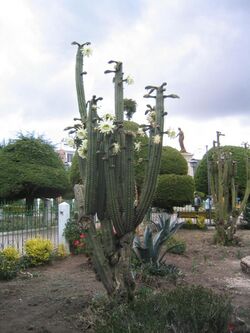Biology:Psychoactive cactus
Many cacti are known to be psychoactive, containing phenethylamine alkaloids such as mescaline.[1] However, the two main ritualistic (folkloric) genera are Echinopsis, of which the most psychoactive species occur in the San Pedro cactus group (including Echinopsis pachanoi, syn. Trichocereus pachanoi, Echinopsis Peruviana, syn. Trichocereus peruvianus and Echinopsis lageniformis, syn. Trichocereus bridgesii[2][3]), and Lophophora, with peyote (Lophophora williamsii) being the most psychoactive species. Several other species pertaining to other genera are also psychoactive, though not always used with a ritualistic intent.[4][5][6]
Species
Globular cacti
- Lophophora williamsii (peyote)
Other "peyotes"
- Ariocarpus fissuratus
- Coryphantha compacta (syn. C. palmeri)
- Pelecyphora aselliformis
- Pelecyphora strobiliformis
- Lophophora diffusa
- Ariocarpus retusus
- Ariocarpus agavoides; kotschoubeyanus; and other species
- Astrophytum asterias; capricorne; myriostigma; and other species
- Aztekium ritteri; and other species
- Coryphantha elephantidens; macromeris (var. runyonii); palmeri; and other species
- Echinocactus grandis; grusonii; platyacanthus; visnaga; and other species
- Epithelantha micromeris; and other species
- Leuchtenbergia principis'; and other species
- Lophophora species
- Mammillaria craigii; grahamii (var. oliviae); heyderi; (Dolichothele) longimamma; (Solisia) pectinifera; (Mamillopsis) senilis; sonorensis; and other species
- Obregonia denegrii
- Strombocactus disciformis
- Turbinicarpus laui; lophophoroides; jauernigii; (Pelecyphora) pseudopectinatus; schmiedickeanus; and other species
Other
Other North American psychoactive and/or medicinal cacti.
- Carnegiea gigantea
- Echinocereus salm-dyckianus (var. scheeri); triglochidiatus; and other species
- Pachycereus pecten-aboriginum; pringlei
Arborescent and columnar cacti
Echinopsis
- Echinopsis lageniformis (syn. Trichocereus bridgesii) (Bolivian torch cactus)
- Echinopsis macrogona (syn. Trichocereus macrogonus), > 0.01-0.05% Mescaline[7]
- Echinopsis pasacana ssp. atacamensis
- Echinopsis pachanoi (syn. Trichocereus pachanoi) (San Pedro cactus)
- Echinopsis peruviana (syn. Trichocereus peruvianus) (Peruvian torch cactus)
- Echinopsis scopulicola (syn. Trichocereus scopulicolus), 0.82% mescaline by dry weight in the outer green layer.[8]
- Echinopsis spachiana (syn. Trichocereus spachianus), Mescaline;[9] Mescaline[9]
- Echinopsis tacaquirensis subsp. taquimbalensis (syn. Trichocereus taquimbalensis),[10] > 0.005-0.025% mescaline[7]
- Echinopsis terscheckii (syn. Trichocereus terscheckii, Trichocereus werdemannianus)[11] > 0.005-0.025% Mescaline;[7] mescaline 0.01%-2.375%[12]
- Echinopsis valida (syn. E. validus), 0.025% mescaline[13]
- Echinopsis werdermannianus

Other
Other South American psychoactive and/or medicinal cacti
- Austrocylindropuntia cylindrica (syn. Opuntia cylindrica),[14] Mescaline[9]
- Armatocereus laetus
- Browningia spp.
- Cylindropuntia echinocarpa (syn. Opuntia echinocarpa), Mescaline 0.01%, DMPEA 0.01%, 4-hydroxy-3-5-dimethoxyphenethylamine 0.01%[9]
- Cylindropuntia spinosior (syn. Opuntia spinosior),[15] Mescaline 0.00004%, 3-methoxytyramine 0.001%, tyramine 0.002%, 3-4-dimethoxyphenethylamine.[9]
- Epostoa lanata
- Matucana madisoniorum
- Neoraimondia macrostibas
- Opuntia acanthocarpa Mescaline[16]
- Opuntia basilaris Mescaline 0.01%, plus 4-hydroxy-3-5-dimethoxyphenethylamine[9]
- Selenicereus grandiflorus
- Stetsonia coryne
See also
- Entheogenic drugs and the archaeological record
- List of Acacia species known to contain psychoactive alkaloids
- List of plants used for smoking
- List of psychoactive plants
- List of psychoactive plants, fungi, and animals
- N,N-Dimethyltryptamine
- Psilocybin mushrooms
Traditional and Indigenous Uses
Several world regions have historically used psychoactive cacti for their properties, particularly Indigenous peoples from North America and South America, such as in Mexico and the Andes region. Archaeological studies have found evidence of use going back two thousand years.[17][18] In 2022, the Peruvian Ministry of Culture declared the traditional use of San Pedro cactus in northern Peru as cultural heritage.[19] Lophophora williamsii (peyote) is used by the Native American Church (aka Peyotism).
Legality
References/Sources
- ↑ Bruhn, Jan G.; Hesham R. EI-Seedi; Nikolai Stephanson (2008). "Ecstasy Analogues Found in Cacti". Journal of Psychoactive Drugs 40 (2): 219–222. doi:10.1080/02791072.2008.10400635. PMID 18720674.
- ↑ Engel, Liam (2022). The San Pedro Appreciation Guide. The Mescaline Garden. https://www.themescalinegarden.com/san-pedro-appreciation-guide.
- ↑ Engel, L. Barratt, M. Ferris, J. Puljevic, C. Winstock, A. (2023). "Mescaline, Peyote and San Pedro: Is sustainability important for cacti consumers?". Journal of Psychedelic Studies. https://akjournals.com/view/journals/2054/aop/article-10.1556-2054.2023.00252/article-10.1556-2054.2023.00252.xml.
- ↑ Bruhn, Jan G. (1973). "Ethnobotanical Search for Hallucinogenic Cacti1". Planta Med 24 (8): 315–319. doi:10.1055/s-0028-1099504. PMID 4789553.
- ↑ Bruhn, Jan G.; Catarina Bruhn (1973). "Alkaloids and ethnobotany of Mexican peyote cacti and related species". Economic Botany 27 (2): 241–251. doi:10.1007/BF02872994.
- ↑ Pummangura, S.; J. L. McLaughlin; R. C. Schifferdecker (September 1981). "Cactus Alkaloids. XLVII. β-Phenethylamines From the "Missouri Pincushion", Coryphantha (Neobessya) missouriensis". J. Nat. Prod. 44 (5): 614–616. doi:10.1021/np50017a022.
- ↑ 7.0 7.1 7.2 "Partial List of Alkaloids in Trichocereus Cacti". Thennok.org. http://www.thenook.org/archives/tek/alklist.htm.
- ↑ Ogunbodede, Olabode; McCombs, Douglas; Trout, Keeper; Daley, Paul; Terry, Martin (September 2010). "New mescaline concentrations from 14 taxa/cultivars of Echinopsis spp. (Cactaceae) ("San Pedro") and their relevance to shamanic practice". Journal of Ethnopharmacology 131 (2): 356–362. doi:10.1016/j.jep.2010.07.021. PMID 20637277. https://www.sciencedirect.com/science/article/abs/pii/S0378874110004836.
- ↑ 9.0 9.1 9.2 9.3 9.4 9.5 "Descriptions of psychoactive Cacti.". Users.lycaeum.org. http://users.lycaeum.org/~iamklaus/botany.htm#.
- ↑ "Echinopsis tacaquirensis ssp. taquimbalensis". Desert-tropicals.com. http://www.desert-tropicals.com/Plants/Cactaceae/Echinopsis_taquimb.html.
- ↑ "Cardon Grande (Echinopsis terscheckii)". Desert-tropicals.com. http://www.desert-tropicals.com/Plants/Cactaceae/Echinopsis_terscheckii.html.
- ↑ Forbidden Fruit Archives
- ↑ "Erowid Cacti Vaults : Visionary Cactus Guide - Mescaline from Sawdust". Erowid.org. http://www.erowid.org/plants/cacti/cacti_guide/cacti_guide_lophopho.shtml.
- ↑ "Austrocylindropuntia cylindrica". Desert-tropicals.com. http://www.desert-tropicals.com/Plants/Cactaceae/Opuntia_cylindrica.html.
- ↑ "Cane Cholla (Cylindropuntia spinosior )". Desert-tropicals.com. http://www.desert-tropicals.com/Plants/Cactaceae/Opuntia_spinosior.html.
- ↑ "Archived copy". http://users.lycaeum.org/~iamklaus/opuntia.htm.
- ↑ Socha, Dagmara M.; Sykutera, Marzena; Orefici, Giuseppe (2022-12-01). "Use of psychoactive and stimulant plants on the south coast of Peru from the Early Intermediate to Late Intermediate Period". Journal of Archaeological Science 148: 105688. doi:10.1016/j.jas.2022.105688. ISSN 0305-4403. https://www.sciencedirect.com/science/article/pii/S0305440322001467.
- ↑ El-Seedi, Hesham R.; Smet, Peter A. G. M. De; Beck, Olof; Possnert, Göran; Bruhn, Jan G. (2005-10-03). "Prehistoric peyote use: Alkaloid analysis and radiocarbon dating of archaeological specimens of Lophophora from Texas". Journal of Ethnopharmacology 101 (1): 238–242. doi:10.1016/j.jep.2005.04.022. ISSN 0378-8741. https://www.sciencedirect.com/science/article/pii/S0378874105002990.
- ↑ El Peruano (2022-11-17). "Declaran Patrimonio Cultural de la Nación a los conocimientos, saberes y usos del cactus San Pedro". https://elperuano.pe/noticia/197142-declaran-patrimonio-cultural-de-la-nacion-a-los-conocimientos-saberes-y-usos-del-cactus-san-pedro.
External links
 |
